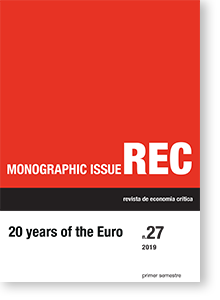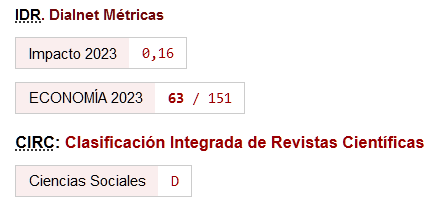The ECB Monetary Strategy: A Critical Assessment
Palabras clave:
ECB monetary policy strategy, monetary policy and inflation , Eurozone monetary reformResumen
This paper aims to provide a critical assessment of the performance of the ECB's monetary strategy, as well as of the substantial "de facto" changes this strategy has undergone from 2010 onwards. These changes have occurred as a consequence of the unforeseen challenges that the eurozone crisis posed to its implicit conventional monetary model of "two pillars". The standpoint of the paper is that the institutional changes the eurozone requires cannot be limited to the so-called institutional failures in the architecture of the European monetary union, but should also be extended to reconsider the underlying theoretical framework that inspires the ECB's monetary strategy.
Descargas
Citas
Alesina, A., Blanchard, O., Galí, J., Giavazzi, F. and Uhlig, H. (2001): Defining a macroeconomic framework for the euro area: Monitoring the European Central Bank, 3. London, Centre for Economic Policy Research.
Bayoumi, T. and B. Eichengreen (1993): "Shocking aspects of European monetary integration", in F. Torres and F. Giavazzi (eds): Adjustment and growth in the European Monetary Union, London: CEPR, Cambridge University Press.
https://doi.org/10.1017/CBO9780511599231.014
Berger, H.; Haan, J. de; and Eijffinger, S.C.W. (2001): "Central Bank Independence: an update of theory and evidence", Journal of Economic Surveys, vol. 15, no. 1, pp. 3-40.
https://doi.org/10.1111/1467-6419.00131
Bibow, J. (2015): "The euro's savior? Assessing the ECB's crisis management performance and potential for crisis resolution", IMK Study 42, June.
https://doi.org/10.2139/ssrn.2671877
Bletzinger, T. and Wieland, V. (2016): "Forward guidance and 'lower for longer': The case of the ECB", Institute for Monetary and Financial Stability, Working Paper no. 102
Bletzinger, T. and Wieland, V. (2017): "Lower for longer: The case of the ECB", Economic Letters, vol. 159, pp. 123-127.
https://doi.org/10.1016/j.econlet.2017.06.030
Breuss, F. (2002): "Is ECB's monetary policy optimal?", Working Paper no. 173, WIFO (Austrian Institute of Economic Research).
Coeuré, B. (2016): "People are not only savers", opinion piece from Benoît Coeuré, Member of the Executive Board of the ECB, for the Frankfurter Allgemeine Sonntagszeitung, 1 May.
Revista de Economía Crítica, nº27, primer semestre 2019, ISSN 2013-5254 30 The ECB Monetary Strategy: A Critical Assessment. Carlos J. Rodríguez Fuentes and David Padrón Marrero
Constâncio, V. (2015): "Assessing the new phase of unconventional monetary policy at the ECB", Panel remarks prepared by Victor Constâncio, Vice-President of the ECB, at the Annual Congress of the European Economic Association, University of Mannheim, 25 august 2015.
Council of the European Communities (1992): Treaty of European Union, Luxembourg, Office for Official Publications of the European Communities.
De Grauwe, P. (1992); The economics of monetary integration, Oxford, Oxford University Press.
De Grauwe, P. (2013); "Design failures in the eurozone: Can they be fixed", LSE' Europe in Question Discussion Paper Series, No. 57/2013, February 2013.
https://doi.org/10.2139/ssrn.2215762
De Grauwe, P. (2015); "Design failures of the Eurozone", column at VOX CEPR Policy Portal, 7 September 2015. [available at https://voxeu.org/article/design-failures-eurozone]
De Grauwe, P. and Polan, M. (2001): "Is inflation always and everywhere a monetary phenomenon", CEPR Discussion Paper no. 2841 [published also in 2005 in the Scandinavian Journal of Economics, vol. 107, no. 2, pp. 239-259].
Dehesa, G. de la (2011); "Eurozone design and management failures", column at VOX CEPR Policy Portal, 18 May 2011. [available at https://voxeu.org/article/eurozone-design-and-management-failures]
Dow, S.C. (2016): "Ontology and Theory for a Redesign of European Monetary Union", World Economic Review, vol. 6, pp. 1-11.
Draghi, M. (2014): "Monetary policy in a prolonged period of low inflation", Speech by Mario Draghi, President of the ECB, at the ECB Forum on Central Banking, Sintra, 26 May 2014.
Draghi, M. (2015): "Monetary policy and structural reforms in the euro area", Speech by Mario Draghi, President of the ECB, at Prometeia40, Bologna, 14 December 2015.
Draghi, M. (2016): "On the importance of policy alignment to fulfil our economic potential", 5th Annual Tommaso Padoa-Schioppa Lecture by Mario Draghi, President of the ECB, at the Brussels Economic Forum 2016, Brussels, 9 June 2016.
ECB (1999): "The stability oriented monetary policy strategy of the Eurosystem", Monthly Bulletin, European Central Bank, January, pp. 39-50.
ECB (2000): "The two pillars of the ECB's monetary policy strategy", Monthly Bulletin, European Central Bank, November, pp. 37-48.
ECB (2003): "The outcome of the ECB's evaluation of its monetary policy strategy", Monthly Bulletin, European Central Bank, June, pp. 79-89.
ECB (2008): "10th Anniversary of the ECB", Monthly Bulletin (Special Edition), European Central Bank, May.
ECB (2011): The Monetary Policy of the ECB (Third Edition), Frankfurt, European Central Bank.
Emerson, M.; Gros, D.; Italianer, A.; Pisani-Ferry, J. and Reichenbach, H. (1992), One market one money. An evaluation of the potential benefits and costs of forming an Economic and Monetary Union, Oxford, Oxford University Press.
Galí, J. (2003): "Monetary policy in the early years of EMU", in M. Buti and A. Sapir (eds.): EMU and Economic Policy in Europe: The Challenges of the early years, Cheltenham, Edward Elgar.
https://doi.org/10.4337/1843761521.00012
Gerlach, S. and Schnabel, G. (1999): "The Taylor rule and interest rates in the EMU area: a note", Working Paper no. 73, Basle, Bank for International Settlements.
https://doi.org/10.2139/ssrn.856944
Goodhart, C. and Illing, G. (2002); "Introduction", in C. Goodhart and G. Illing (eds), Financial Crises, Contagion, and the Lender of Last Resort, a Reader, Oxford, Oxford University Press.
https://doi.org/10.1093/oso/9780199247202.001.0001
Hayo, B. and Hefeker, C. (2002): "Reconsidering central bank independence", European Journal of Political Economy, vol. 18, pp. 653-674.
https://doi.org/10.1016/S0176-2680(02)00113-1
Issing, O. (2006): "The ECB's Monetary Policy Strategy: Why did we choose a two Pillar Approach?", Paper presented at The role of money: money and monetary policy in the twenty-first century, 4th ECB Central Banking Conference, held at Frankfurt, 10 November 2006
Issing, O., Gaspar, V., Angeloni, I. and Oreste, T. (2001): Monetary Policy in the Euro Area: Strategy and Decision Making at the European Central Bank, Cambridge, Cambridge University Press.
https://doi.org/10.1017/CBO9780511492457
Jakab, Z. and Kumhof, M. (2015): "Banks are not intermediaries of loanable funds and why this matters", Bank of England, Working Paper no. 525, May 2015.
https://doi.org/10.2139/ssrn.2612050
Kenen, P. (1969); "The Theory of Optimum Currency Areas: An Eclectic View'" in R. Mundell and A. Swoboda (eds), Monetary Problems of the International Economy, Chicago: University of Chicago Press.
Krugman, P. (1993); "Lessons of Massachusetts for EMU", in F. Torres and F. Giavazzi (eds.), Adjustment and Growth in the European Monetary Union, London: CEPR, Cambridge University Press.
https://doi.org/10.1017/CBO9780511599231.016
Malo de Molina J. L. (2011); "La crisis y las insuficiencias de la arquitectura institucional de la moneda única", Información Comercial Española, vol. 863, pp. 21-34.
McKinnon, R. (1963); "Optimum Currency Areas", American Economic Review, vol. 53, pp. 717-25.
Minsky, H. P. (1982); Inflation, recession and economic policy, Brighton: Wheatsheaf.
Mundell, R. (1961); "A Theory of Optimal Currency Areas", American Economic Review, vol. 51, no. 4, pp. 657-65.
Pisani-Ferry, J. (2018); "Euro area reform: An anatomy of the debate", VOX CEPR Policy Portal, 2 October 2018. [available at https://voxeu.org/article/euro-area-reform-anatomy-debate]
Roubini, N. (2016): "The Global Economy's New Abnormal", column at Project Syndicate, 4 February 2016. [available at https://www.project-syndicate.org/commentary/market-volatility-in-global-economyby-nouriel-roubini-2016-02?barrier=accesspaylog]
Taylor, J.B. (1993): "Discretion versus policy rules in practice", Carnegie-Rochester Conference Series on Public Policy, vol. 39, pp. 195-214.
https://doi.org/10.1016/0167-2231(93)90009-L
Taylor, J.B. (1999): "The robustness and efficiency of monetary policy rules as guidelines for interest rate setting by the European Central Bank", Journal of Monetary Economics, vol. 43, no. 3, pp. 655-679.
https://doi.org/10.1016/S0304-3932(99)00008-2
Trichet, J.C. (2008): "Address at the ceremony to mark the 10th anniversary of the European Central Bank and the European System of Central Banks", Speech delivered by Jean-Claude Trichet, President of the ECB, 2 June 2008, Frankfurt am Main.
von Hagen, J. and Brückner, M. (2002): "Monetary and fiscal policy in the European Monetary Union", IMES Discussion Paper Series, no. 2002-E-16, Bank of Japan.
Descargas
Publicado
Cómo citar
Número
Sección
Licencia
Esta licencia permite a terceros compartir (copiar y redistribuir el material en cualquier medio o formato) y adaptar (remezclar, transformar y crear a partir del material para cualquier finalidad, incluso comercial), siempre que se reconozca la autoría y la primera publicación en esta revista (La Revista, DOI de la obra), se proporcione un enlace a la licencia y se indique si se han realizado cambios en la obra.







